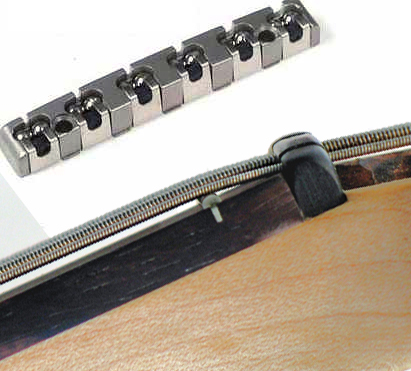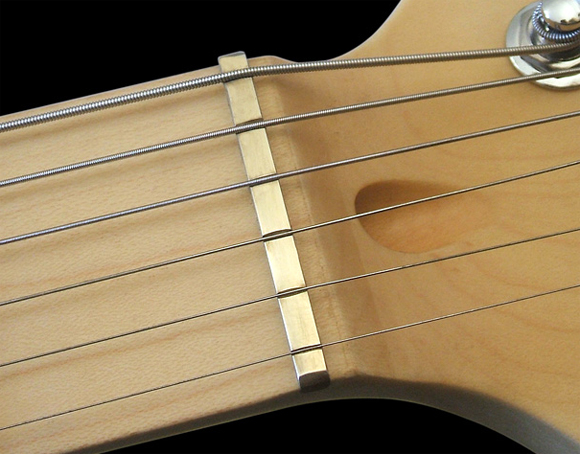
Visit the new website: www.buildyourownguitaronline.com
HOME > Guitar nut materials and sound properties
GUITAR NUT MATERIAL AND SOUND PROPERTIES
On any guitar or bass you will find that the portion of vibrating string rests on two points, the bridge and the nut.
The nut can be built using different materials such as:

The material which the nut is made of influences the sound of an instrument, mainly because of the notes played as open strings and the difference between them and those played on the frets.
The only way to achieve the same sound on the strings played as on the open string, consists in using a "zero fret" instead of the nut, i.e. a slightly higher fret than the others (or a metal nut, for example made of brass or steel).

Here is a description of the different materials and sound:
-
Zero fret. Used since the '50s, the "zero fret" represents the best modern solution for the installation of the nut on instruments equipped with a fixed bridge.
Bone. A bone nut built to perfection, is the best solution for any instrument including those equipped with a vibrato bridge. The bone combines volume and an even frequency response, with robustness and reliability for tuning, allowing the strings to slide like on graphite. Moreover it never wears out, something which can happen with plastic made nuts.
-
Ivory. Ivory is very similar to bone but more expensive a hard material to work with and slightly brighter soundwise.
-
Micarta, Corian. They sound mediocre and tend to wear out easily.
-
Graphite. The use of graphite is fashionable if you intend to make serious use of the tremolo. The sound is balanced and the graphite is a good compromise between timbre and performance.
-
TUSQ/Graphtech. It is the synthetic material that most closely resembles bone in sound. It is made of polymers pressed at very high temperatures that are close to the density and sound of the bone.
-
Brass. This is the material closest to the composition of the fret itself so the one that can guarantee no difference between the sound of the open string and that of the note played on the frets. Moreover, it is practically indestructible but painstaking to craft.
-
Steel. Also on the market are nuts made of steel, equipped with bearings or small cylindrical supports where the strings rest (see Fender LRS). Steel is an excellent material if you are not looking for a particularly "vintage" sound and are looking for a little more shine.

The video below shows how a nut should be made. This video is the first of a series of 5 explaining the perfect strat setup for tremolo use.


